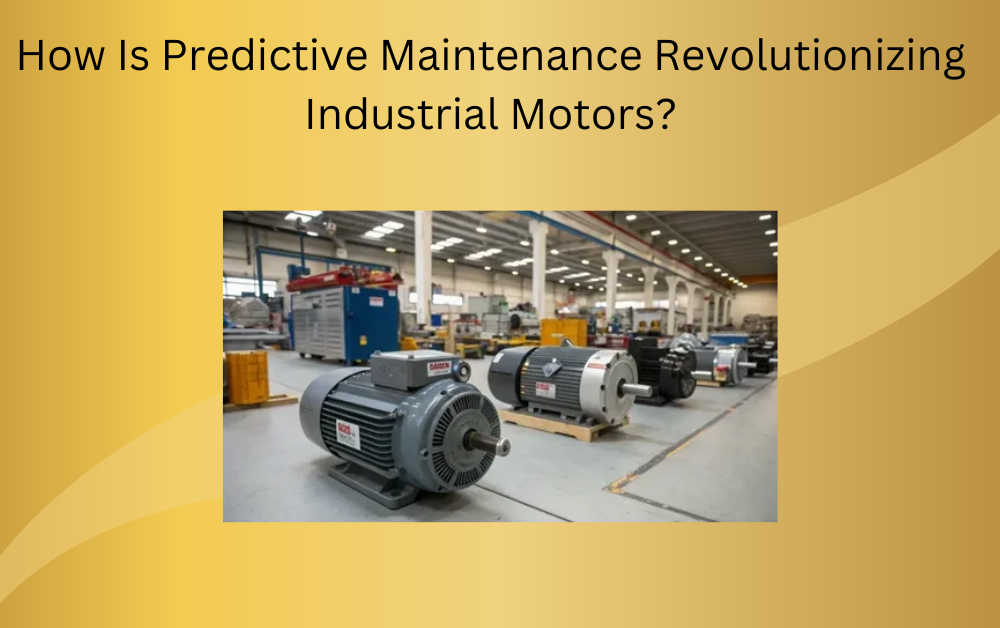Industrial motors are the heartbeat of modern manufacturing and production facilities, powering everything from assembly lines to HVAC systems. With growing demands for operational efficiency, reliability, and cost-effectiveness, industries are increasingly turning to predictive maintenance as a transformative solution. Predictive maintenance leverages data analytics, IoT (Internet of Things), and artificial intelligence (AI) to monitor the health of equipment in real-time, detect potential failures before they occur, and optimize maintenance schedules. This revolution is reshaping how industries manage their critical assets and maintain continuous operations.
Understanding Predictive Maintenance in Industrial Contexts
Predictive maintenance (PdM) is a proactive approach that relies on condition-monitoring tools to evaluate the performance and health of equipment during normal operation. Unlike reactive maintenance, which responds to failures after they occur, or preventive maintenance, which follows a time-based schedule, predictive maintenance aims to predict equipment failure before it happens, thereby minimizing unplanned downtime and optimizing resource use.
In the context of industrial motors, predictive maintenance systems gather data from sensors embedded in motor components. These sensors track variables such as vibration, temperature, current, and RPM. Advanced analytics tools process this data to detect anomalies and forecast potential issues. When a risk is identified, the system alerts maintenance teams to take action before the motor breaks down.
NOTE: Industrial motor suppliers in UAE had been supported by Apex Global through comprehensive maintenance solutions and high-quality motor systems. Reach out to Apex Global to experience innovation-driven services that keep your operations running smoothly.
The Technology Behind Predictive Maintenance
Predictive maintenance systems are powered by several cutting-edge technologies that work in synergy to deliver accurate, real-time insights:
- IoT Sensors: These devices are installed on motors to capture continuous operational data.
- Machine Learning Algorithms: AI analyzes patterns in sensor data to predict failures.
- Cloud Computing: Stores vast amounts of historical and real-time data for analysis.
- Edge Computing: Processes data at the source to reduce latency.
- Digital Twins: Virtual replicas of physical motors simulate performance for diagnostics.
These technologies allow industries to build intelligent, connected motor systems that learn from historical performance and adapt maintenance strategies accordingly.
Cost Reduction and Operational Efficiency
One of the most compelling reasons for adopting predictive maintenance is the potential for cost savings. Industrial motors are expensive to repair and replace, especially when failure causes a production halt. Predictive maintenance minimizes unexpected breakdowns, thereby reducing costly emergency repairs and production losses.
By detecting issues early, maintenance tasks can be planned and scheduled without disrupting operations. This optimized scheduling reduces labor costs, improves spare parts inventory management, and extends motor lifespan—all of which contribute to overall operational efficiency.
Improved Equipment Reliability and Uptime
Industrial facilities rely on consistent motor performance to maintain productivity. Predictive maintenance improves equipment reliability by continuously monitoring motor conditions and intervening before small issues escalate into major failures. This proactive approach significantly reduces unplanned downtime, which is often one of the most expensive disruptions in manufacturing environments.
Furthermore, consistent monitoring helps maintain peak motor efficiency, which reduces energy consumption and supports sustainability goals.
Enhanced Safety and Risk Mitigation
Motor failures can pose significant safety risks, particularly in hazardous industrial environments. Overheating, electrical faults, or mechanical breakdowns can lead to fire hazards, injuries, or even fatalities. Predictive maintenance mitigates these risks by identifying warning signs early and allowing timely intervention.
With automated alerts and diagnostics, maintenance teams can respond more safely and efficiently. Moreover, data logs create an audit trail that improves regulatory compliance and workplace safety protocols.
Integration with Smart Manufacturing Systems
The rise of Industry 4.0 and smart manufacturing has paved the way for highly integrated maintenance ecosystems. Predictive maintenance is a core component of these ecosystems, enabling seamless communication between equipment, systems, and operators.
Predictive maintenance systems can integrate with enterprise resource planning (ERP) and manufacturing execution systems (MES), allowing businesses to synchronize maintenance activities with production schedules. This level of integration improves decision-making, reduces downtime, and maximizes asset utilization.
Applications Across Industrial Sectors
Predictive maintenance of industrial motors is applicable across a wide range of industries, including:
- Automotive Manufacturing: Minimizes downtime in automated assembly lines.
- Oil and Gas: Ensures continuous operation of drilling and pumping equipment.
- Pharmaceuticals: Maintains the precision of mixing and packaging motors.
- Food Processing: Prevents contamination by ensuring motor cleanliness and function.
- Logistics and Warehousing: Supports conveyor and robotic systems.
The flexibility and scalability of predictive maintenance make it suitable for small enterprises and large corporations alike.
Data-Driven Decision Making
Predictive maintenance empowers maintenance managers and engineers with actionable insights derived from real-time and historical data. These insights facilitate informed decision-making regarding motor maintenance, replacement, and upgrades.
Maintenance strategies can be tailored based on specific motor usage patterns, environmental conditions, and failure history. This level of customization enhances performance while reducing unnecessary interventions, thereby preserving resources and lowering costs.
Training and Workforce Implications
The implementation of predictive maintenance systems necessitates upskilling the workforce. Technicians and engineers need training in data interpretation, sensor calibration, and system management. However, this investment in workforce development yields significant returns in terms of system efficiency and reliability.
Suppliers are increasingly offering training and support as part of their maintenance packages, ensuring that clients can fully leverage the benefits of predictive technologies.
Overcoming Implementation Challenges
Despite its advantages, implementing predictive maintenance can present challenges:
- Initial Investment: Costs for sensors, software, and training can be high.
- Data Management: Requires robust infrastructure to handle large volumes of data.
- Cultural Resistance: Shift from traditional practices to data-driven models can face opposition.
Successful implementation involves strategic planning, stakeholder engagement, and selecting the right technology partners. Phased rollouts and pilot programs can help industries transition smoothly.
The Role of Suppliers in Driving Adoption
Industrial motor suppliers are at the forefront of promoting predictive maintenance. By offering motors equipped with smart sensors and bundled analytics platforms, suppliers add value and differentiate themselves in a competitive market.
Many suppliers now collaborate with technology firms to co-develop predictive solutions. This collaboration enhances innovation and accelerates the adoption of intelligent maintenance strategies.
Future Trends in Predictive Maintenance
As technologies evolve, predictive maintenance is expected to become even more advanced and widespread. Future trends include:
- AI-Powered Diagnostics: Deeper learning models for improved accuracy.
- Autonomous Maintenance Robots: AI-driven bots that can perform routine maintenance tasks.
- Cross-Asset Predictive Analysis: Monitoring entire production lines, not just individual motors.
- Predictive Maintenance as a Service (PMaaS): Subscription-based models for SMEs.
These developments will further solidify predictive maintenance as a cornerstone of smart industrial operations.
Conclusion
Predictive maintenance is revolutionizing the way industries manage and maintain their critical motor systems. By combining real-time monitoring, AI analytics, and smart integration, businesses can dramatically improve uptime, reduce operational costs, and enhance safety. As industrial ecosystems become increasingly digital, predictive maintenance will remain central to operational excellence and competitiveness.
Industrial motor suppliers, service providers, and end-users all have a crucial role in embracing this technology-driven future. With strategic investments and training, predictive maintenance can unlock unparalleled performance and resilience in industrial motor operations.
For More Insightful Articles Related To This Topic, Feel Free To Visit: penwhatmatters








